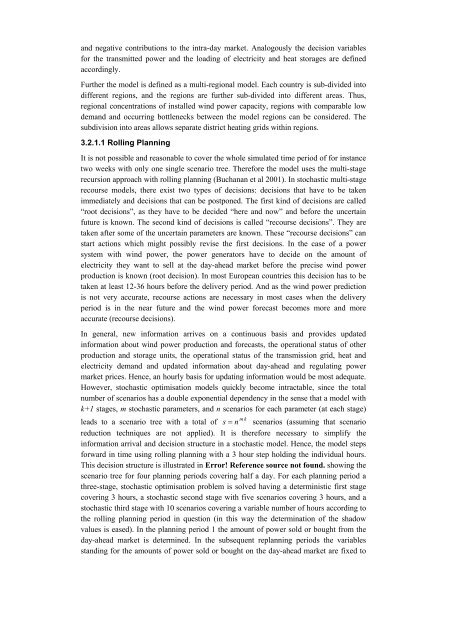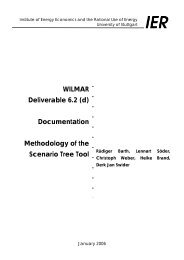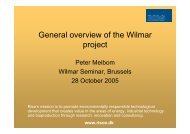Final Technical Report - WILMAR Wind Power Integration in ...
Final Technical Report - WILMAR Wind Power Integration in ...
Final Technical Report - WILMAR Wind Power Integration in ...
You also want an ePaper? Increase the reach of your titles
YUMPU automatically turns print PDFs into web optimized ePapers that Google loves.
and negative contributions to the <strong>in</strong>tra-day market. Analogously the decision variables<br />
for the transmitted power and the load<strong>in</strong>g of electricity and heat storages are def<strong>in</strong>ed<br />
accord<strong>in</strong>gly.<br />
Further the model is def<strong>in</strong>ed as a multi-regional model. Each country is sub-divided <strong>in</strong>to<br />
different regions, and the regions are further sub-divided <strong>in</strong>to different areas. Thus,<br />
regional concentrations of <strong>in</strong>stalled w<strong>in</strong>d power capacity, regions with comparable low<br />
demand and occurr<strong>in</strong>g bottlenecks between the model regions can be considered. The<br />
subdivision <strong>in</strong>to areas allows separate district heat<strong>in</strong>g grids with<strong>in</strong> regions.<br />
3.2.1.1 Roll<strong>in</strong>g Plann<strong>in</strong>g<br />
It is not possible and reasonable to cover the whole simulated time period of for <strong>in</strong>stance<br />
two weeks with only one s<strong>in</strong>gle scenario tree. Therefore the model uses the multi-stage<br />
recursion approach with roll<strong>in</strong>g plann<strong>in</strong>g (Buchanan et al 2001). In stochastic multi-stage<br />
recourse models, there exist two types of decisions: decisions that have to be taken<br />
immediately and decisions that can be postponed. The first k<strong>in</strong>d of decisions are called<br />
“root decisions”, as they have to be decided “here and now” and before the uncerta<strong>in</strong><br />
future is known. The second k<strong>in</strong>d of decisions is called “recourse decisions”. They are<br />
taken after some of the uncerta<strong>in</strong> parameters are known. These “recourse decisions” can<br />
start actions which might possibly revise the first decisions. In the case of a power<br />
system with w<strong>in</strong>d power, the power generators have to decide on the amount of<br />
electricity they want to sell at the day-ahead market before the precise w<strong>in</strong>d power<br />
production is known (root decision). In most European countries this decision has to be<br />
taken at least 12-36 hours before the delivery period. And as the w<strong>in</strong>d power prediction<br />
is not very accurate, recourse actions are necessary <strong>in</strong> most cases when the delivery<br />
period is <strong>in</strong> the near future and the w<strong>in</strong>d power forecast becomes more and more<br />
accurate (recourse decisions).<br />
In general, new <strong>in</strong>formation arrives on a cont<strong>in</strong>uous basis and provides updated<br />
<strong>in</strong>formation about w<strong>in</strong>d power production and forecasts, the operational status of other<br />
production and storage units, the operational status of the transmission grid, heat and<br />
electricity demand and updated <strong>in</strong>formation about day-ahead and regulat<strong>in</strong>g power<br />
market prices. Hence, an hourly basis for updat<strong>in</strong>g <strong>in</strong>formation would be most adequate.<br />
However, stochastic optimisation models quickly become <strong>in</strong>tractable, s<strong>in</strong>ce the total<br />
number of scenarios has a double exponential dependency <strong>in</strong> the sense that a model with<br />
k+1 stages, m stochastic parameters, and n scenarios for each parameter (at each stage)<br />
m k<br />
leads to a scenario tree with a total of s =<br />
n scenarios (assum<strong>in</strong>g that scenario<br />
reduction techniques are not applied). It is therefore necessary to simplify the<br />
<strong>in</strong>formation arrival and decision structure <strong>in</strong> a stochastic model. Hence, the model steps<br />
forward <strong>in</strong> time us<strong>in</strong>g roll<strong>in</strong>g plann<strong>in</strong>g with a 3 hour step hold<strong>in</strong>g the <strong>in</strong>dividual hours.<br />
This decision structure is illustrated <strong>in</strong> Error! Reference source not found. show<strong>in</strong>g the<br />
scenario tree for four plann<strong>in</strong>g periods cover<strong>in</strong>g half a day. For each plann<strong>in</strong>g period a<br />
three-stage, stochastic optimisation problem is solved hav<strong>in</strong>g a determ<strong>in</strong>istic first stage<br />
cover<strong>in</strong>g 3 hours, a stochastic second stage with five scenarios cover<strong>in</strong>g 3 hours, and a<br />
stochastic third stage with 10 scenarios cover<strong>in</strong>g a variable number of hours accord<strong>in</strong>g to<br />
the roll<strong>in</strong>g plann<strong>in</strong>g period <strong>in</strong> question (<strong>in</strong> this way the determ<strong>in</strong>ation of the shadow<br />
values is eased). In the plann<strong>in</strong>g period 1 the amount of power sold or bought from the<br />
day-ahead market is determ<strong>in</strong>ed. In the subsequent replann<strong>in</strong>g periods the variables<br />
stand<strong>in</strong>g for the amounts of power sold or bought on the day-ahead market are fixed to




